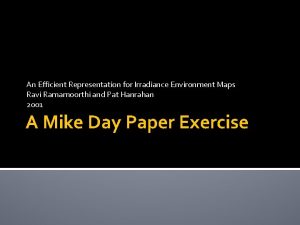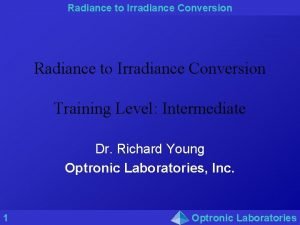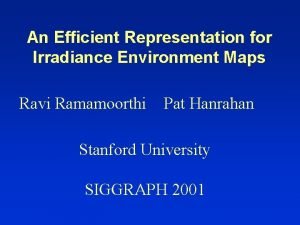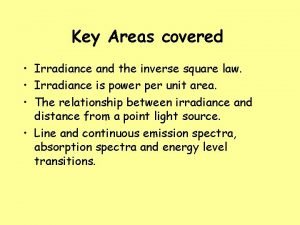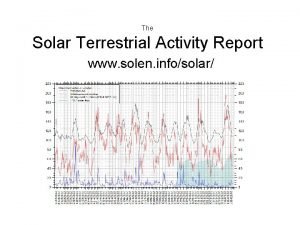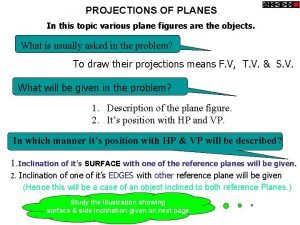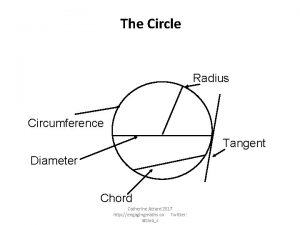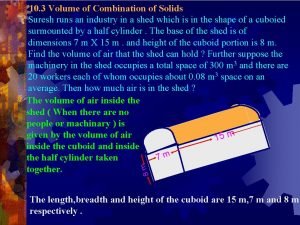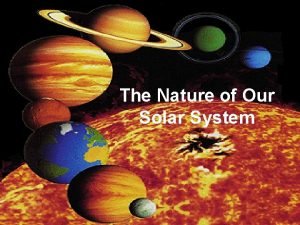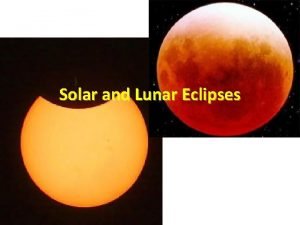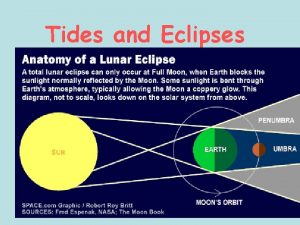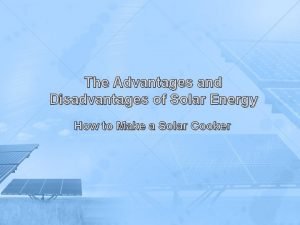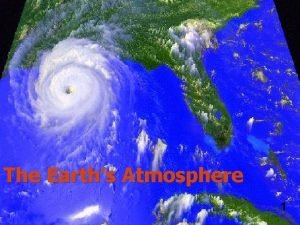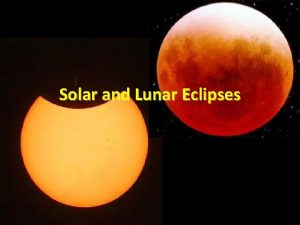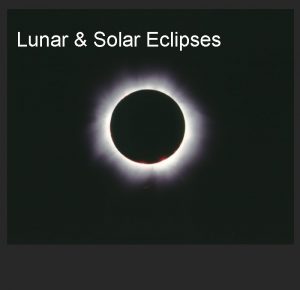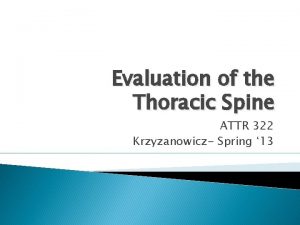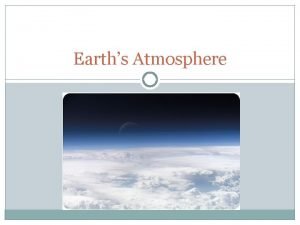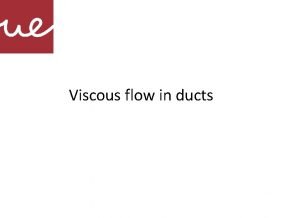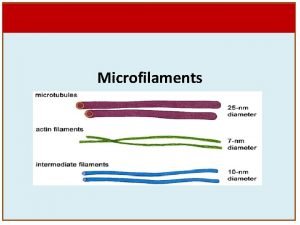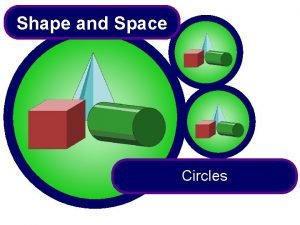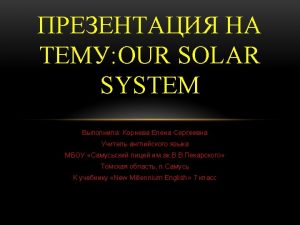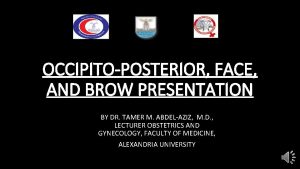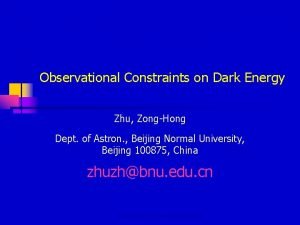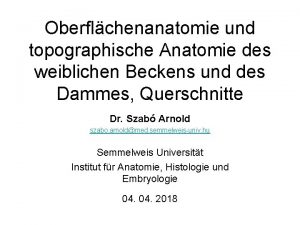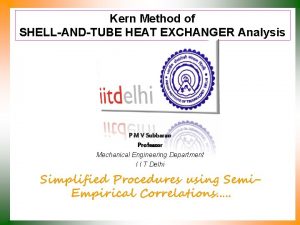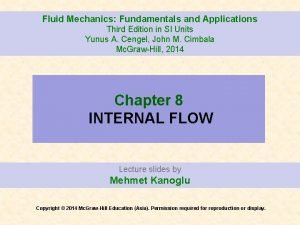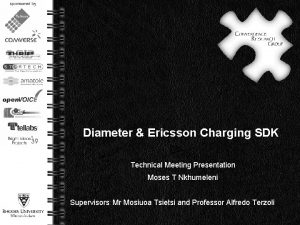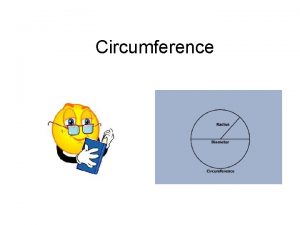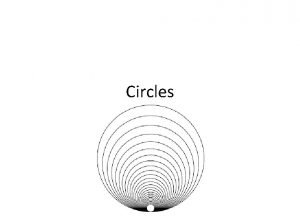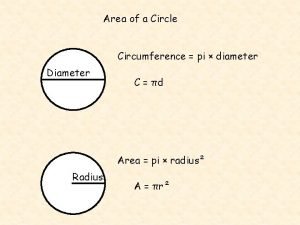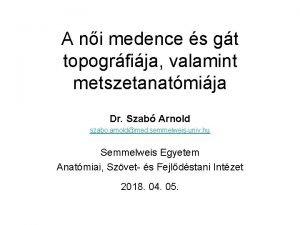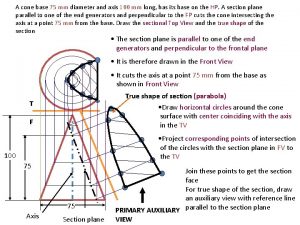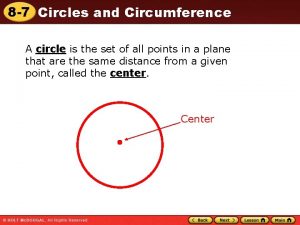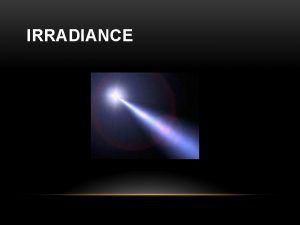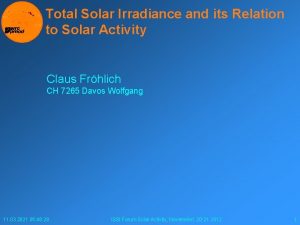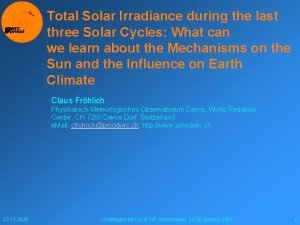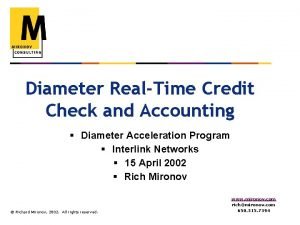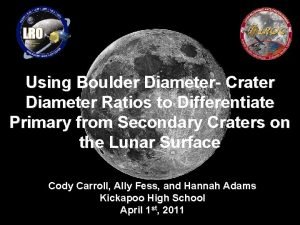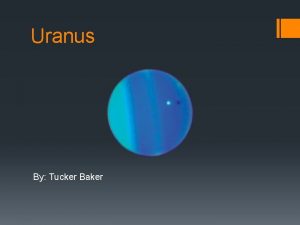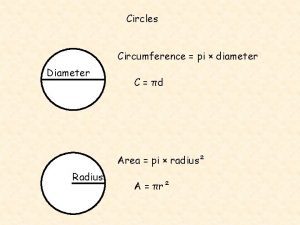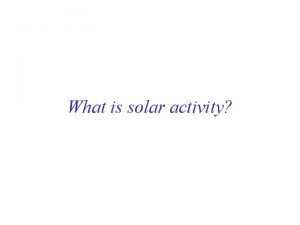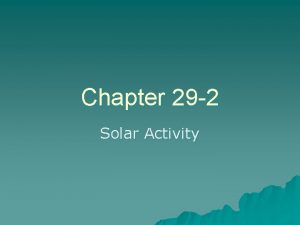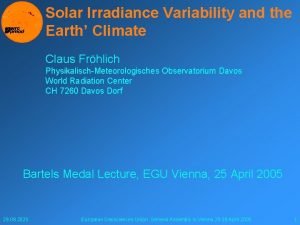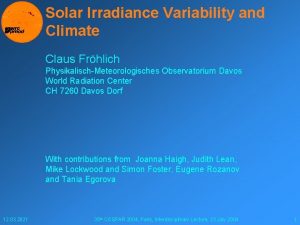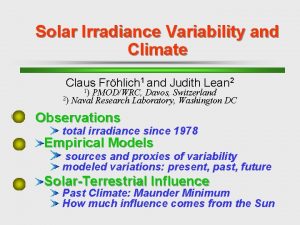Solar Irradiance Diameter Shape and Activity J R










































































![Delayed Oscillator Bf F(t) G(t) Flux storage and “heating” in RZ, G[a, e] RZ Delayed Oscillator Bf F(t) G(t) Flux storage and “heating” in RZ, G[a, e] RZ](https://slidetodoc.com/presentation_image/cde4cbedfdc2883d29c9175aede51595/image-75.jpg)






- Slides: 81

Solar Irradiance, Diameter, Shape, and Activity J. R. Kuhn, Institute for Astronomy, University of Hawaii Rock Bush Marcelo Emilio Isabelle Scholl Phil Scherrer GONG 10, June 2010

What can we learn about the solar cycle from precise “global” measurements?

…since 2002 • A solar cycle of MDI; HMI debuts • More than a solar cycle of helioseismic measurements • COROT, “night-time solar physics”

Global solar properties Luminosity and irradiance Luminosity, radius, temp Frequency, magnetic field, temperature ‘Even’ m-dependent frequency splittings

Is solar the irradiance change primarily luminosity change?

Frequencies and F 10. 7 Broomhall et al. 2009

Even coefficient frequency splittings Splitting coefficient temporal variability qualitatively describes surface magnetism changes

Its hard to change the solar surface temperature by changing solar luminosity

The solar limb is largely fixed by rapid opacity decline “few km” thick transition from opaque to transparent

Solar radius, past results from under the atmosphere….

A fluctuating solar radius is seen from the ground • 76 yr fluctuation with 0. 2 arcsec half-amplitude • 11 yr fluctuation, smallest sun at peak in sunspot number with 0. 1 arcsec halfamplitude 76 yrs

Solar astrometry: Is the Sun shrinking? • 0. 05 – 0. 2 arcsec/century Gilliland, 1981

Limb astrometry from Space NB: Telescope diffraction limit has very little to do with astrometric accuracy dr Angle of arrival fluctuations define dr d. I Photometric gain uncertainty (flatfielding) defines dr In practice limb isn’t knife edge, spacecraft pointing jitter is about 0. 01 pixel (and correlated!), long term stability limitations are due to optics thermal drifts [(MDI) 1 px=2”]

Limb Astrometry Systematic Errors • Spacecraft pointing jitter (not limiting) – “coherent” – MDI, 0. 02 arcsec • Optical errors (limiting) – Temporal stability • Thermal changes, dimensional stability, index changes – Spatial changes • Field focus variations – Two orders of magnitude larger than solar signals (MDI, 0. 5 arcsec) – “Roll” calibration essential • MDI approach – Measure and calibrate all aspects of instrument – PROVEN: Shape measurements essentially achieved photometric precision (i. e. oblateness/hexadecapole uncertainty 0. 5 mas in 12 images)

HMI Solar Limb Astrometry • What Limb Astrometry from HMI? – The solar radius variations with time (and oscillations) – The solar radius variations with central angle (shape, and oscillations) • Why Do This With HMI? – Can’t be done on the ground with HMI accuracy (in some cases by two orders of magnitude) – HMI will surpass MDI astrometric accuracy by at least one order of magnitude – These are difficult measurements, no other space experiment addresses the same technical issues and no other space experiment reproduces the HMI astrometric approach • What are the pressing questions? – Does the solar radius change (at all) with solar cycle? • Knowledge of radius changes and irradiance or luminosity changes constrains the solar cycle mechanisms… a long debated problem – What is the Sun’s shape and is this consistent with solar system limits on its gravitational potential and the internal rotation rate? – Limb Oscillations (p-modes, g-modes, r-modes) dispersion relation information has yet to be carefully measured and interpreted

Satellite limb profiles

MDI Raw Radius Data

Calibrated MDI astrometry systematics Front window: 6 C gradient 1. 5 km focal length 0. 84” Primary lens: 10 C temperature focal shift -0. 2” OSS expansion: 10 C temperature change expansion 0. 75”

Instrument changes

The solar radius change…

The solar radius over time km

No solar cycle radius changes! • W = dr/r / d. L/L < 2 x 10 -2 – Solar cycle luminosity is much smaller than irradiance change – Solar asphericity and 2 D atmosphere structure dominates d. R and d. L – Solar cycle frequency changes not due primarily to changing geometry (s) • Some models can predict small W, c. f. Mullan et al. 2007 (although H- opacity effects on ‘radius’ ignored? )

Asphericity and solar shape • Are solar cycle irradiance variations due to redistribution of emergent solar luminosity? – Latitudinal variation, d. R(μ)/R – MDI and HMI solar shape measurements Modern ground-based solar shape measurements

Limb astrometry, MDI 6 -50 pixel annulus 480 pix MDI: 1. 96” pixel HMI: 0. 5” pix

HMI raw shape and limb photometry pole equator See GONG 10 Bush et al. poster

Rolling HMI separates solar shape from optical distortion Satellite roll angle cos 2θ cos 3θ cos 4θ cos 5θ

MDI and HMI sun during some rolls has no magnetic activity MDI: March 1997 MDI: Nov. 2009 HMI: April 9 2010 HMI: April 16 2010 MDI roll in 2001 available, but active sun HMI roll available every 6 months

Oblateness from 1997 -2010 MDI and HMI observations without magnetic corrections 1997 MDI 2009 MDI 2010 a HMI 2010 b HMI

MDI Solar minimum (1997) and maximum (2001) roll data

MDI limb shape analysis, magnetic contamination – e. g. 2001 • Magnetic contamination increases limb brightness, decreases limb radius • Note scale: 40 mas radius decrease, 0. 01 intensity increase

After accounting for magnetic activity, the limb shape is still variable Active latitutes: If we missed magnetic contributions, oblateness would be even larger!

Solar oblateness isn’t constant MDI and HMI Solar shape data But note: Fivian et al. 2007 from RHESSI claim 2006 oblateness is surface value

RHESSI photometry technique Fivian, Hudson, Lin, 2007

Oblateness coefficient variability from RHESSI

Helioseismic splittings also sample solar shape • These are tiny shape variations, 2001 to 2010 Req. Rpole change is about 2. 5 km, smaller than our limits on the solar cycle mean radius variation • Helioseismic “oblateness” (the “even” frequency splitting coefficients) are anticorrelated with geometric oblateness • Acoustic (interior) atmosphere non-homologously expanding with respect to “surface” (Kosovichev, Lefebvre 1995, 1996) • Oblateness changes are too small to account for even coefficient variations (and opposite in sign)

The solar brightness, ground, MDI, HMI Ground Oblateness Measurements HMI MDI

Solar cycle acoustic changes • Primarily NOT geometric effects (in mean frequencies or splittings) • The solar atmosphere change with cycle is not well described by any 1 -dimensional model (either magnetic or thermal) • Diffuse, unresolved, magnetic flux and surface brightness is needed

“Superficial” vs. “seeing the tachocline” • Tough problem: “everything” is correlated with possibly complex causal connections (cf. Basu et al. 2009 “hints of tachocline” visible in helioseismic time dependence) • Magnetic vs. “thermal”

Deep origins of magnetized plasma must carry excess entropy to surface Photosphere Convection Zone Magnetized fluid is “hotter” Thermal “antishadows” Solar cycle magnetic fields Temperature gradient enhanced stable stratification becomes unstable Tachocline region Radiative Zone Radiative flux through magnetized fluid sees lower opacity and increased entropy relative to non-magnetized fluid Over a solar cycle magnetized fluid over 11 yr increases entropy by 0. 1% at base of SCZ

Alternatively, vertical surface B fields decrease vertical “irradiance” Continuum contrast vs. vertical orientation and Ca. K contrast The integrated disk brightness change due to bright faculae is 38% of the faint faculae “Bright” faculae are dark, at any wavelength near disk center Data from the Precision Photometric Solar Telescope NB: cf. Ken Topka facular contrast results

Magnetic fields and irradiance

Fast and slow B vs. irradiance Fast variations: B increases “I” Slow variations: B decreases I

Frequency variations are not determined simply by solar activity (from Broomhall et al. 2009)

Global photometric timeseries analysis • Solar and stellar observations converge studies of resolved stellar magnetic atmospheres are happening: Night-time solar physics

Spots and faculae may produce only a tiny luminosity pertubation (flux redistribution) T/4 d. I time Use solar rotation to describe angular variation in active region or spot “irradiance” … luminosity

Full-disk observations show flux redistribution (data high-pass filtered with 60 d moving-mean) Regardless of phase of the solar cycle (min-to-max) the irradiance autocorrelation shows clear evidence that active regions (faculaea nd sunspots) redistribute flux. Low temporal frequency signal shows evidence of additional luminosity signal

Co. Ro. T Photometry – stay tuned

Conclusions • Very precise global solar measurements are important for understanding the solar cycle • Solar cycle helioseismic effects are primarily thermal or magnetic sound speed effects (not geometry) • One-dimensional models don’t convincingly account for cycle variations heterogenous, unresolved (mixed) magnetic field effects are required


Magnetized plasma from RZ is hotter At the top of the radiative zone. . . Tachocline region l BP 6 MG, l. P 3 E 5 cm Tachocline shear layer unresolved helioseismically, l. O 0. 018 R (Schatzman et al. 2000)



Helioseismic changes Irradiance changes Surface brightness changes A useful solar cycle model must connect and explain all of these observations, none exists yet

• What was the question? • • Boundaries are great “Superficialist” problems Listening to the data Clocks

Driving the Solar Cycle

Irradiance changes +0. 1 W/m^2/G The slow variations using 30 d averages are plotted here -0. 2 W/m^2/G This plot shows the residual from the 150 d moving means.

Helioseismic asphericity (Vorontsov, 2002) (Antia et al. 2001) (1989) 26 n. Hz/G 140 n. Hz/K

Irradiance/luminosity change • Suppose 4 DT/T = DI/I, so 0. 1 W/m^2/G implies 0. 1 K/G solar cycle change • If magnetic field causes thermal stratification change and frequency shifts then 26/140 K/G = 0. 18 K/G

The tachocline: Where luminosity perturbations come from? Photosphere Convection Zone Magnetized fluid is “hotter” Thermal “antishadows” Solar cycle magnetic fields Temperature gradient enhanced stable stratification becomes unstable Tachocline region Radiative Zone Radiative flux through magnetized fluid sees lower opacity and increased entropy relative to non-magnetized fluid Over a solar cycle magnetized fluid over 11 yr increases entropy by 0. 1% at base of SCZ

Magnetized plasma from RZ is hotter At the top of the radiative zone. . . Tachocline region l BP 6 MG, l. P 3 E 5 cm Tachocline shear layer unresolved helioseismically, l. O 0. 018 R (Schatzman et al. 2000)

More numbers. . .

• During the solar cycle a thin layer of magnetized plasma at the top of the radiative zone is eroded away from above by convective penetration, brought on by this radiative instability. This “relaxation oscillator” could be characterized by the condition on B that leads to instability and the higher enthalpy per magnetic energy density. • Observable: Flux which originates from the RZ must have a higher enthalpy/magnetic energy density than magnetized fluid generated by CZ or photospheric mechanisms.

Superficial two component (faculae+spots) irradiance models • Models based on resolved Ca. K images or B flux have been used to “explain” irradiance Observed time-variable irradiance Observed time and latitudinal facular/spot dist. (determined by proxy) Facular/spot irradiance contrast function . mis cosine central angle Models which use a statistical fit to determine the coefficients b and k can account for 70 -90% of the irradiance variability (c. f. Solanki, Lean and collaborators)

Superficial, two component faculae + spot models are empirical and imcomplete The integrated disk brightness change due to bright faculae is 38% of the faint faculae “Bright” faculae are dark, at any wavelength near disk center Data from the Precision Photometric Solar Telescope NB: Ken Topka substantially made this point 8 years ago!

How does the convection zone transport heat? • mixing-length diffusion conflicts

MLT convection fails to estimate SCZ conductivity Non-mixing length theory (realistic) solar convection has highly correlated vertical flows. The effective conductivity of the solar convection zone is far from mixing length theory approximations (images from Georgobiani Stein, and Kuhn) small perturbations are diffusive but anisotropic and with conductivity much smaller than mixing length predictions

• Transport properties of the perturbed convection zone aren’t analogous to a “high conductivity silver slab. ” Correlated flows over many density scale heights make the CZ anisotropic and not as well mixed as mixing length models predict.

Superficial models miss time dependence of irradiance componets sunspot peak Total irradiance F = 0. 08 E 0. 005 B -0. 09 E 0. 01 d. B/dt Spot and facular signals peak about 1 year before luminosity signal

Spots and faculae may produce only a tiny luminosity pertubation (flux redistribution) If irradianceis due to flux redistribution, its autocorelation must yield a negative “dip” at T/4=7 d due to opposite sign flux enhancements between normal and near-tangent viewing angles T/4 d. I time We use solar rotation to describe angular variation in active region or spot “irradiance” … luminosity

Full-disk observations show flux redistribution (data high-pass filtered with 60 d moving-mean) Regardless of phase of the solar cycle (min-to-max) the irradiance autocorrelation shows clear evidence that active regions (faculae and sunspots) redistribute flux. Low temporal frequency signal shows evidence of additional luminosity signal. NB Frolich finds more complex behavior in VIRGO data. . .

Superficial models miss irradiance and luminosity distinction • Immediate effect of B flux appearing at low latitudes is to decrease irradiance (flux directed away from normal direction) -- this is d. B/dt term of regression for I(t) • Long term effect is from higher entropy magnetized plasma to increase solar luminosity in proportion to B flux

Superficial models miss diffuse irradiance component

Solar cycle changes Photometry from Mt. Wilson, previous cycle implied this limb temperature MDI Roll data photometry imply this limb temperature distribution Most of a solar cycle was obtained from Mt. Wilson oblateness expt.

Phase properties
![Delayed Oscillator Bf Ft Gt Flux storage and heating in RZ Ga e RZ Delayed Oscillator Bf F(t) G(t) Flux storage and “heating” in RZ, G[a, e] RZ](https://slidetodoc.com/presentation_image/cde4cbedfdc2883d29c9175aede51595/image-75.jpg)
Delayed Oscillator Bf F(t) G(t) Flux storage and “heating” in RZ, G[a, e] RZ CZ Flux diffusion and winding in CZ, F[b, d]

Delayed Oscillator Output

Solar Cycle Effects Delayed oscillator - correlated driving amplitude and phase delay in RZ. Higher amplitudes imply shorter periods (8%). . .

Solar cycle phase regulation • Solar cycle coherence and amplitude variability hint at a stable storage or steady flux transport process, i. e. Babcock. Leighton stochastic flux transport, not intrinsically non-linearity mechanisms

To do. . . • find the complete luminosity budget of surface magnetic fields • find B (and d. B/dt) at tachocline • determine d. Q/d. B from first principles • build a relaxation delayed oscillator model for the full CZ


Magnetized fluid is “hotter” Photosphere Convection Zone Solar cycle magnetic fields Thermal “antishadows” Temperature gradient enhanced stable stratification becomes unstable Tachocline region Radiative Zone Radiative flux through magnetized fluid sees lower opacity and increased entropy relative to non-magnetized fluid Over a solar cycle magnetized fluid over 11 yr increases entropy by 0. 1% at base of SCZ
 An efficient representation for irradiance environment maps
An efficient representation for irradiance environment maps Irradiance to radiance conversion
Irradiance to radiance conversion Irradiance environment map
Irradiance environment map Inverse square law irradiance
Inverse square law irradiance Vray brute force vs light cache
Vray brute force vs light cache Wholesale panel solar cell
Wholesale panel solar cell Solar energy is free. solar is inexhaustible
Solar energy is free. solar is inexhaustible Shape matching and object recognition using shape contexts
Shape matching and object recognition using shape contexts Template matching
Template matching Solen.info solar
Solen.info solar Drag divergence mach number
Drag divergence mach number Activity corrections
Activity corrections Reactants, products and leftovers
Reactants, products and leftovers Aoa in project management
Aoa in project management Activity 1 introductory activity
Activity 1 introductory activity Activity 2 finding the sequence
Activity 2 finding the sequence Activity 2 whats the term
Activity 2 whats the term 3
3 How to label the radius of a circle
How to label the radius of a circle Find the radius and diameter of each circle
Find the radius and diameter of each circle Tactile fremitus
Tactile fremitus Draw the projection of a regular hexagon of 25mm side
Draw the projection of a regular hexagon of 25mm side Upper hood guard and full diameter saw guard
Upper hood guard and full diameter saw guard Radius and diameter of a circle
Radius and diameter of a circle Circle radius diameter chord circumference
Circle radius diameter chord circumference Power tools must be fitted with guards and
Power tools must be fitted with guards and In the adjacent figure the height of a solid cylinder
In the adjacent figure the height of a solid cylinder Uranus belt
Uranus belt Solar power satellites and microwave power transmission
Solar power satellites and microwave power transmission Solar energy is radiant light and heat from the sun
Solar energy is radiant light and heat from the sun Differentiate between lunar eclipse and solar eclipse
Differentiate between lunar eclipse and solar eclipse Difference between solar cell and photodiode
Difference between solar cell and photodiode Tides and eclipses
Tides and eclipses My very excited mother just
My very excited mother just Advantages and disadvantages of solar cooker
Advantages and disadvantages of solar cooker Troposphere facts
Troposphere facts What is an eclipse
What is an eclipse Lunar solar exo
Lunar solar exo Bucket handle movement
Bucket handle movement Why do thermal inversion layers trap pollutants
Why do thermal inversion layers trap pollutants Diameter of breast height
Diameter of breast height Vertical
Vertical Percussion of posterior thorax
Percussion of posterior thorax Diameter of microfilament
Diameter of microfilament Bispinous diameter
Bispinous diameter Chordal ring
Chordal ring Spring board geometry
Spring board geometry How to find circumference if you have diameter
How to find circumference if you have diameter Diameter signalling security
Diameter signalling security How to find the area of a circle
How to find the area of a circle Memeriksa persinggungan pelapis sepatu dan tromol rem
Memeriksa persinggungan pelapis sepatu dan tromol rem Diameter of mercury
Diameter of mercury Presenting diameter in occipito posterior
Presenting diameter in occipito posterior Angular diameter turnaround
Angular diameter turnaround Lig. pubocervicale
Lig. pubocervicale Ukuran lubang pengeboran ditentukan oleh diameter
Ukuran lubang pengeboran ditentukan oleh diameter Lesson 10
Lesson 10 Triangular pitch formula
Triangular pitch formula Aorta diameter normal
Aorta diameter normal Boxnel wagon
Boxnel wagon Fluid mechanics fundamentals and applications
Fluid mechanics fundamentals and applications Circumference of a bowl
Circumference of a bowl Tidal percussion
Tidal percussion Ericsson diameter sdk
Ericsson diameter sdk Pelvis diameter
Pelvis diameter Radius circumference diameter
Radius circumference diameter Interior angle of a circle
Interior angle of a circle 20 cm circumference
20 cm circumference Diameter from circumference
Diameter from circumference Radius diameter chord secant tangent
Radius diameter chord secant tangent Sinciput presentation
Sinciput presentation Diameter bumi
Diameter bumi Blood drop height vs diameter graph
Blood drop height vs diameter graph Pada garis dimensi/penunjuk ukuran menggunakan garis
Pada garis dimensi/penunjuk ukuran menggunakan garis How to find diameter of a circle
How to find diameter of a circle Area in circumference
Area in circumference Diameter of colon
Diameter of colon Tuber ischiadicum
Tuber ischiadicum Lig pubocervicale
Lig pubocervicale A cone base 75mm diameter
A cone base 75mm diameter 7 circles in a circle
7 circles in a circle Posterior lung fields
Posterior lung fields
